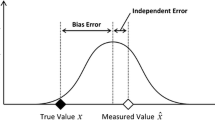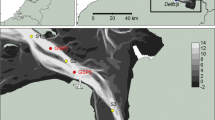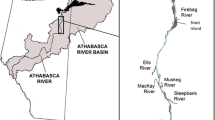Abstract
Purpose
In sediment transport modeling, several sources of uncertainty exist that impinge on the variability of model results. Therefore, it is essential to conduct an uncertainty analysis to quantify the impact of these uncertainties, to detect regions of enhanced sensitivity and subsequently to determine a range of possible model outcomes.
Materials and methods
The first-order second moment method with numerical differentiation is applied to assess the uncertainties of a 2D sediment transport model Hydro_FT-2D at the Lower River Salzach. In comparison to other methods, the first-order second moment method has benefits in terms of total time requirement since it uses considerably less simulation runs to determine model uncertainty. In total, eight uncertain parameters are investigated including both model and river specific parameters. For this purpose, only 2n + 1 simulation runs are necessary leading to a total of 17 simulations. The results are evaluated against a reference simulation regarding bed elevation changes, bed load transport rates, grain size distribution, and total riverbed evolution volume.
Results and discussion
The results of the total riverbed evolution volume indicate a large influence of the investigated river specific parameters roughness of river channel (k st ), grain roughness (k s ), and bed load input rate of the upstream River Saalach (QS SAAL). Among the model specific parameters, the critical Shields parameter (θ crit) and the scaling factor of Meyer-Peter and Mueller equation (MPM) have a significant effect on the model results. Moreover, a spatial evaluation of the maximum and minimum parameter-specific deviation from the reference indicates sensitive areas in regions with poor descriptive data as well as in close vicinity to weirs, ramps, and lateral inflows. In these areas, the model predictions are subject to a high degree of uncertainty and have to be taken with caution.
Conclusions
The applied first-order second moment method with numerical differentiation is a powerful method to identify sensitive areas within the numerical model and to gain knowledge on both uncertain model and river specific parameters. Based on the results, the variability of model outputs can be evaluated and assessed with respect to the uncertainty in the input parameters and can thus contribute to a deeper understanding of the model behavior, which is highly beneficial for long-term morphodynamic studies. The method is found to be applicable for sediment transport models especially in an applied engineering context and for long-term simulation runs due to the simplicity of implementation as well as the reasonable total time requirement.







Similar content being viewed by others

References
Aquaveo (2013) SMS user manual (v11.1) surface-water modeling system. http://smsdocs.aquaveo.com/SMS_User_Manual_v11.1.pdf. Accessed 25 July 2016
Baart F, Van Gelder P, Van Koningsveld M (2011) Confidence in real-time forecasting of morphological storm impacts. J Coast Res 1835
Baldassarre GD, Montanari A (2009) Uncertainty in river discharge observations: a quantitative analysis. Hydrol Earth Syst Sci 13:913–921
Davies AG, Villaret C (2003) Sediment transport modelling for coastal morphodynamics. In: Proceedings of Coastal Sediments. Citeseer, p 18–23
Fortunato AB, Bertin X, Oliveira A (2009) Space and time variability of uncertainty in morphodynamic simulations. Coast Eng 56:886–894
Haff PK (1996) Limitations on predictive modeling in geomorphology. In: The Scientific Nature of Geomorphology: Proceedings of the 27th Binghamton Symposium in Geomorphology, Held 27–29 September, 1996. John Wiley & Sons, p 337
Hieu MT, Nowak W, Kopmann R (2015) Using algorithmic differentiation for uncertainty analysis. Presented at the 22nd Telemac-Mascaret User Conference 2015, STFC Daresbury Laboratory. doi:https://doi.org/10.5281/zenodo.165522
Kopmann R, Brudy-Zippelius T (2012) Using reliability methods for quantifying uncertainties in a 2D–morphodynamic numerical model of River Rhine. Presented at the 2nd IAHR Europe Congress 2012, Munich, Germany
Kopmann R, Schmidt A (2008) Reliability analysis of two-dimensional morphodynamic model results. In: River flow 2008: Proceedings of the 4th International Conference on Fluvial Hydraulics, Çeşme, Izmir, Turkey
Kopmann R, Schmidt A (2010) Comparison of different reliability analysis methods for a 2D morphodynamic numerical model of River Danube. In: River flow 2010: Proceedings of the 5th International Conference on Fluvial Hydraulics, Braunschweig, Germany
Kopmann R, Merkel U, Riehme J (2012) Using reliability analysis in morphodynamic simulation with TELEMAC-2D / SISYPHE. Presented at the 19th Telemac-Mascaret User Conference 2012, Oxford, United Kingdom
Kreisler A, Moser M, Aigner J, Rindler R, Tritthart M, Habersack H (2017) Analysis and classification of bedload transport events with variable process characteristics. Geomorphology 291:57–68
Melching CS (1992) An improved first-order reliability approach for assessing uncertainties in hydrologic modeling. J Hydrol 132:157–177
Melching CS, Anmangandla S (1992) Improved first-order uncertainty method for water-quality modeling. J Environ Eng 118:791–805
Meyer-Peter E, Müller R (1948) Formulas for bed-load transport. Proceedings of the International Association for Hydraulic Research. Third Annual Conference, Stockholm, Sweden, p 39–64
Morris GL, Fan J (1998) Reservoir sedimentation handbook: design and management of dams, reservoirs, and watersheds for sustainable use. McGraw-Hill, New York
Nujic M, Hunziker R, Hydrotec (2015a) Benutzerhandbuch Hydro_AS-2D - 2d Strömungsmodell für die wasserwirtschaftliche Praxis. Aachen (in German)
Nujic, M, Hunziker R, Hydrotec (2015b) Benutzerhandbuch Hydro_FT-2D - Erweiterung zu Hydro_AS-2D zur Simulation des Stofftransports. Aachen (in German)
Pappenberger F, Beven KJ (2006) Ignorance is bliss: or seven reasons not to use uncertainty analysis. Water Resour Res 42:5. https://doi.org/10.1029/2005WR004820
Pinto L, Fortunato AB, Freire P (2006) Sensitivity analysis of non-cohesive sediment transport formulae. Cont Shelf Res 26:1826–1839
Rachlewicz G, Zwoliński Z, Kociuba W, Stawska M (2017) Field testing of three bedload samplers’ efficiency in a gravel-bed river, Spitsbergen. Geomorphology 287:90–100
Sadid N, Beckers F, Haun S, Noack M, Wieprecht S (2016) An evolution volume balance approach to determine relevant discharge threshold for bed load transport. In: Hydrodynamic and mass transport at freshwater aquatic interfaces. Presented at the 34th International School of Hydraulics, GeoPlanet: Earth and Planetary Sciences, Zelechów, Poland
Shields A (1936) Anwendung der Ähnlichkeitsmechanik und der Turbulenzforschung auf die Geschiebebewegung. Preussischen Versuchsanstalt für Wasserbau, Berlin (in German)
Villaret C, Kopmann R, Wyncoll D, Riehme J, Merkel U, Naumann U (2016) First-order uncertainty analysis using algorithmic differentiation of morphodynamic models. Comput Geosci 90:144–151
Wentworth CK (1922) A scale of grade and class terms for clastic sediments. J Geol 30:377–392
Wilks DS (2006) Statistical methods in the atmospheric sciences, 2nd edn. International geophysics series. Academic Press, Burlington
WRS (2000) Untersuchungen zur Flußmorphologie der Unteren Salzach. Wasserwirtschaftliche Rahmenuntersuchung Salzach, Fachbericht Nr. 2, Bayerisches Landesamt für Wasserwirtschaft, München, 2000 (in German)
WRS (2002) Geschiebetransportmodellierung. Wasserwirtschaftliche Rahmenuntersuchung Salzach, Fachbericht Nr. 4, Bayerisches Landesamt für Wasserwirtschaft, München, 2002 (in German)
Yen BC, Cheng ST, Melching CS (1986) First order reliability analysis. Stochastic and risk Analysis in hydraulic Engineering. Water Resources Publications, Littleton, Colorado, p 1–36
Author information
Authors and Affiliations
Corresponding author
Additional information
Responsible editor: Rui Miguel Lage Ferreira
Rights and permissions
About this article
Cite this article
Beckers, F., Noack, M. & Wieprecht, S. Uncertainty analysis of a 2D sediment transport model: an example of the Lower River Salzach. J Soils Sediments 18, 3133–3144 (2018). https://doi.org/10.1007/s11368-017-1816-z
Received:
Accepted:
Published:
Issue Date:
DOI: https://doi.org/10.1007/s11368-017-1816-z



